Growing Heirloom Tomatoes In Pots
As an Amazon Associate and member of other affiliate programs, I earn from qualifying purchases.
Growing heirloom tomatoes in pots is very doable, and in this post, we’re giving away all our best tips. The choice to grow heirloom tomato varieties is very popular with home gardeners because of their tried and true growth habit and predictable flavor and production rate.
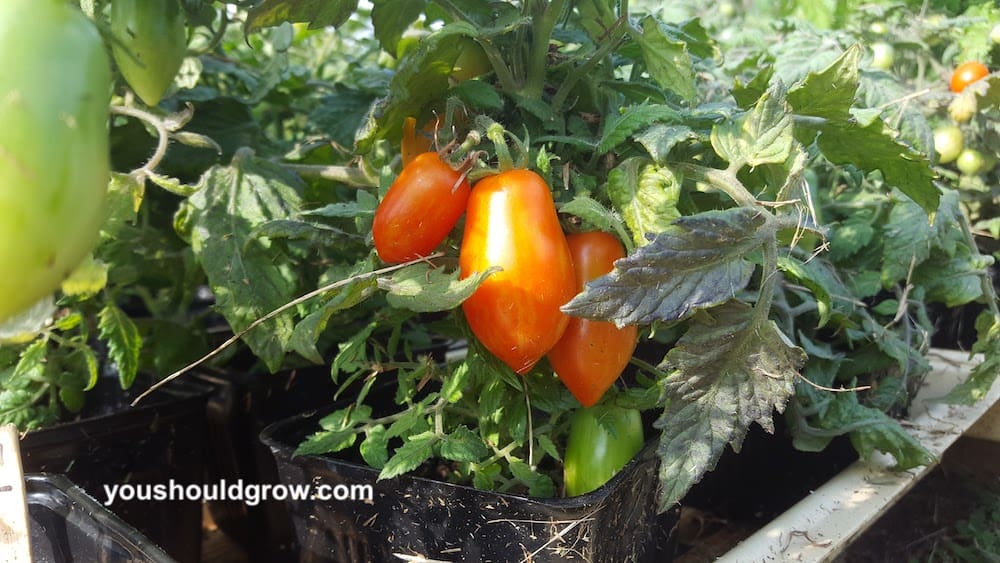
What is an heirloom tomato?
While we like to think that an heirloom tomato is a variety of tomato that has been passed down for generations, the reality is that seed catalogs do not keep track of the age of a tomato variety. Rather, tomato seeds are marketed as heirloom varieties if the plant is considered open-pollinated.
Open pollinated and heirloom varieties of tomatoes are genetically stable so you can expect tomato plants grown from saved seed to be identical to the parent plant. Heirloom tomatoes are well suited to all types of gardening…from raised beds to 5 gallon buckets.
When you’re growing tomatoes in pots, you have complete control of location, potting soil, and watering. And despite what you may have heard, tomatoes do really well when grown in containers.
Best heirloom tomatoes for containers
You can grow any tomato in containers, but the best choices are the more compact plants. Of the two types, determinate tomatoes tend to be smaller. But there are also dwarf and microdwarf plants that can be grown in even the smallest of containers.
Determinate tomatoes for containers
Indeterminate tomatoes for containers
Moskvich
Brandywine
Cherokee purple
Best containers for growing tomatoes
The most important characteristic of a pot for growing tomatoes is the size. We recommend that you use the largest size container you have. If the container is too small, you can stunt the growth of the roots which will lead to fewer and less tasty tomatoes.
Most heirloom tomatoes are indeterminate tomatoes, and they’ll grow into a large plant that can be 6+ feet tall and wide. So you need to give them plenty of space for strong roots and room for stakes to tie them up. We recommend at least a 10 gallon pot (these are similar to what we use).
5 gallon buckets are more suited to smaller plants, so think about getting a dwarf variety for containers that small.
There are hundreds of varieties of tomato plants and choosing the right variety for your growing conditions can quickly get overwhelming. But if you’re not growing from seed, you’ll have a lot fewer options.
Best potting mix for growing tomatoes
The quality of your soil is directly related to the health of your plants and the flavor of your tomatoes. A good potting soil retains moisture without getting soggy, has balanced nutrients and lots of organic matter, and has a pH between 6.5 and 6.8.
Promix is a good brand to choose for growing tomatoes. A mixture of 50:50 potting soil and compost makes an excellent growth medium for tomatoes.
Whatever you do, do not try to plant tomatoes in pots you fill with soil from your garden. True garden soil may not drain well in containers, plus you will possibly bring in disease and weed seeds to your containers.
Choose the right location for your tomatoes
Tomatoes need a minimum of 6 hours of direct sunlight to produce fruit. If your tomatoes are growing in shade, they’ll be smaller and make fewer flowers and fruit.
For those of us who live in locations where summer temps top 90F, look for a location that gets morning sun and offers a bit of shade in the heat of the day. Temps over 90F will decrease your tomato production.
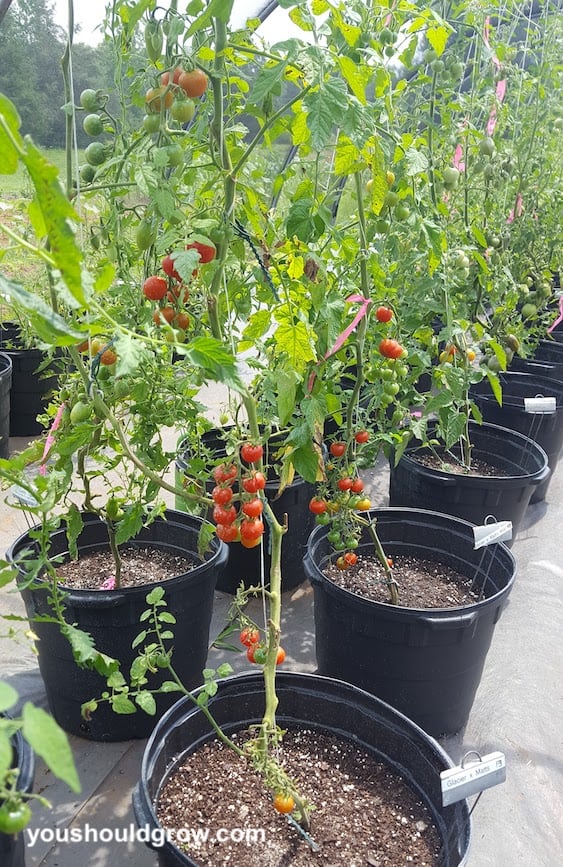
How to support tomatoes in pots
Make sure to have a plan for supporting your tomato plants. This is especially true for plants grown in containers. For dwarf plants, your standard tomato cage will do, but for larger plants, try tying them to a trellis or suspended string is a great option.
However you decide to tie up your tomato plant, it’s always better to allow it to grow vertically than to allow it to sprawl across the ground. Sprawling tomato plants are more prone to disease and pest issues.
Best way to prune tomatoes in pots
If you’re growing indeterminate tomato plants, then you should prune the suckers to get larger tastier fruit. A sucker is a new branch that sprouts from the main stem of your tomato plant. You’ll see them forming in the crook where a leaf meets the stem.
Suckers grow into stems that make lots of flower clusters and more tomatoes, but they also draw on the nutrients and water in your tomato pot. And as suckers grow into stems they make more suckers.
So you can see it easily gets crowded and the nutrient and water demands increase if you don’t prune.
How often to fertilize tomatoes in containers
If you’ve chosen a good quality potting soil, you may not need to fertilize your plants. However, if your plants don’t seem to be growing or the leaves are pale or yellow, those are good signs your soil needs fertilizer.
Fertilizing up to once per month with an organic liquid fertilizer will give the best results without risking burning your plants. It’s important to choose an appropriate fertilizer for the growth stage of your tomatoes.
Early on, they’ll need more nitrogen so fish fertilizer (like this) is great for young and growing tomato plants. When it’s time to make flowers and fruit, choose a fertilizer lower in nitrogen and higher in phosphorus (this one is the bomb).
How often to water tomatoes growing in pots
If there were an easy answer to this, then I would surely give it to you! But the truth is there is no hard and fast rule about how often to water your tomatoes. The timing of watering your plants really depends on a lot of factors including the weather, where you placed your plants, and how well your containers are draining.
If it’s really hot and your plants are in 8+ hours of direct sun, they may need to be watered twice daily. If it’s been cool and they get some shade from the afternoon heat, you may need to water every 2-3 days. The best thing to do is to check the soil in your containers every day.
If you poke into the soil with your finger, is it dry about an inch down? If so, then go ahead and water. When you water your tomatoes, be sure to water the soil in the container.
Tomatoes do not take up very much water from their leaves, and wet leaves can lead to disease problems. So make sure you’re watering at the base of the plant and not sprinkling water on the tops of the plant.
Controlling pests
You may have some problems with pests when growing tomatoes in pots. Check for eggs and tiny bugs on the undersides of your tomato leaves. Other signs of pests include curling leaves, holes in leaves or fruit, or sticky residue on your leaves and fruit.
In many cases, simply picking and squishing pests is enough, but if the problem gets out of hand try some organic pesticide treatments.
Summary
Tomatoes adapt well to container gardening. The size and location of your container have a significant effect on your results. If you’ve been hesitant to grow tomatoes in pots, try these tips for the best success.
- Choose a large container with good drainage
- Fill your container with a good quality potting mix and compost.
- Place your tomato in at least 6 hours of sunlight with morning sun preferred to afternoon sun
- Use stakes, strings, or trellises to encourage your tomato to grow vertically
- Prune suckers off indeterminate plants to control growth
- Watch for signs your plants need fertilizer and provide food as much as once monthly
- Monitor for pests and water needs daily.


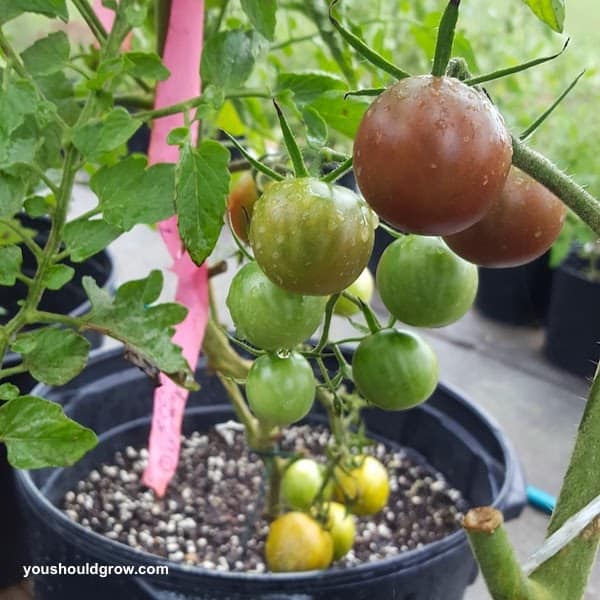
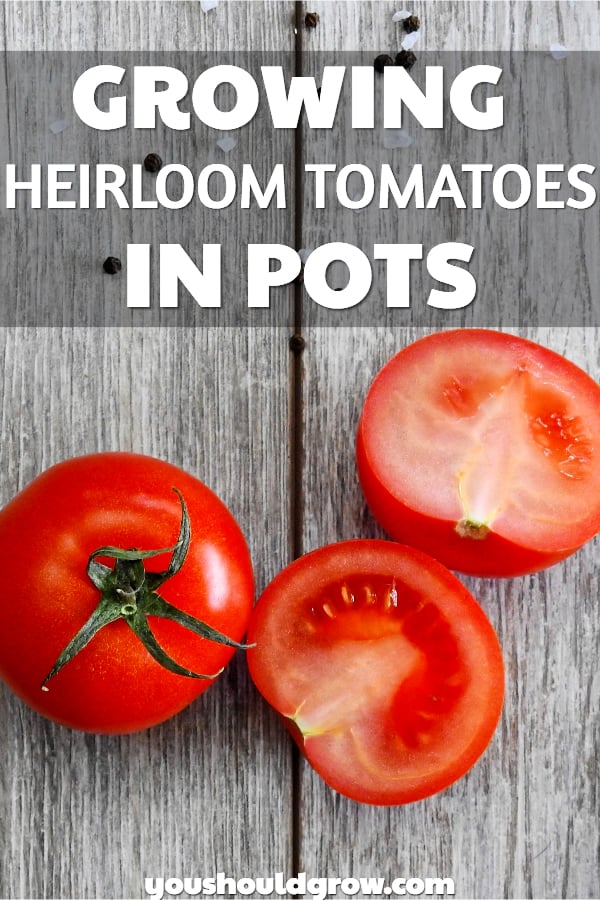
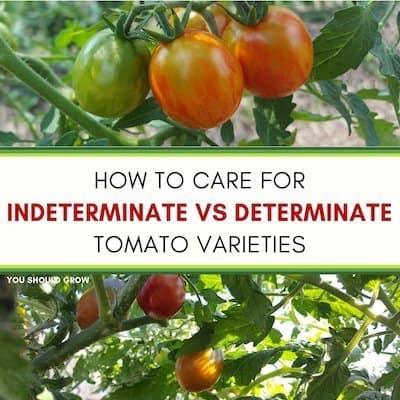
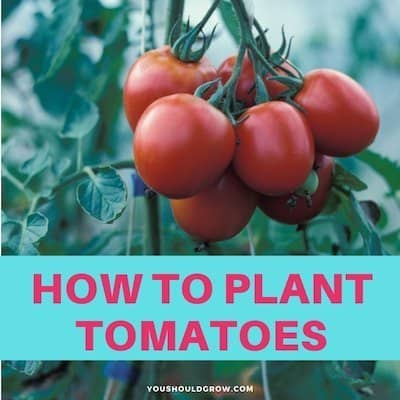
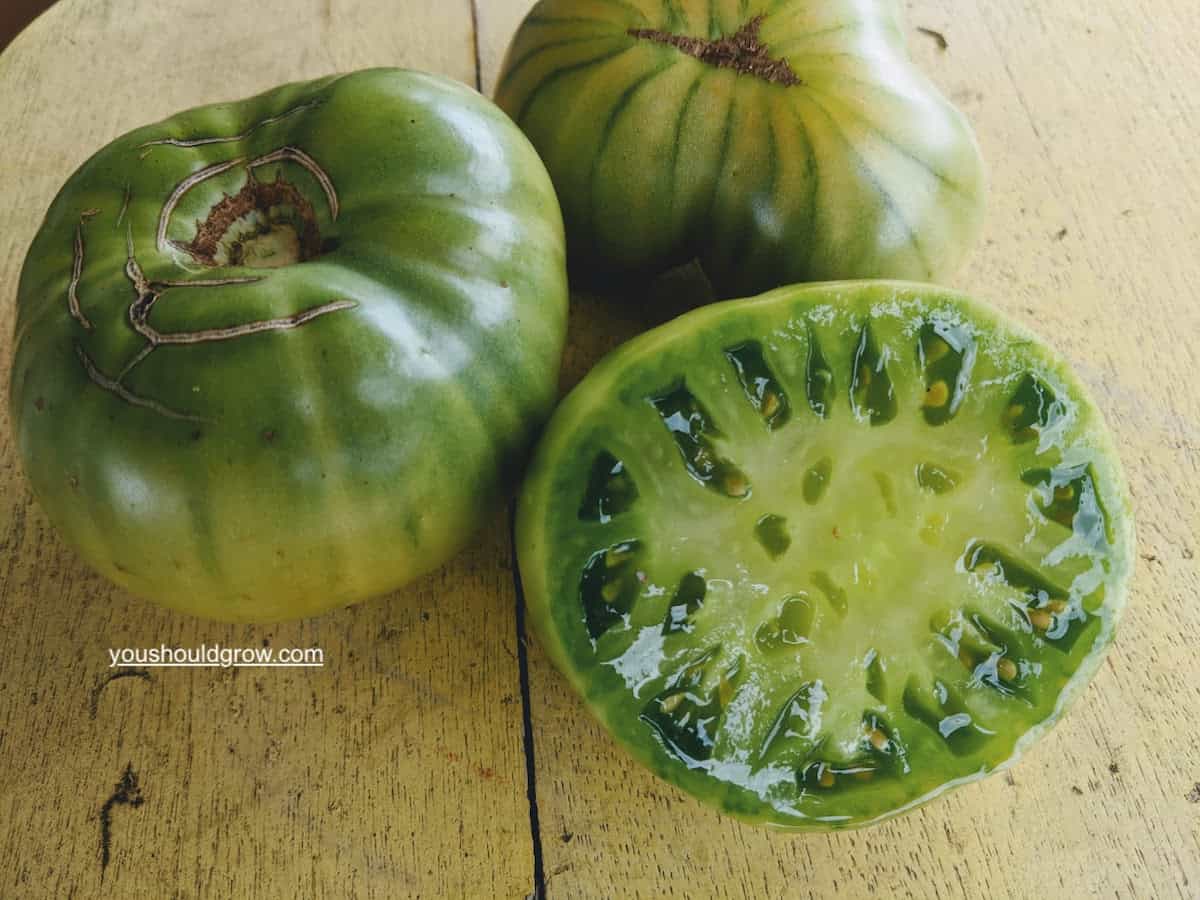
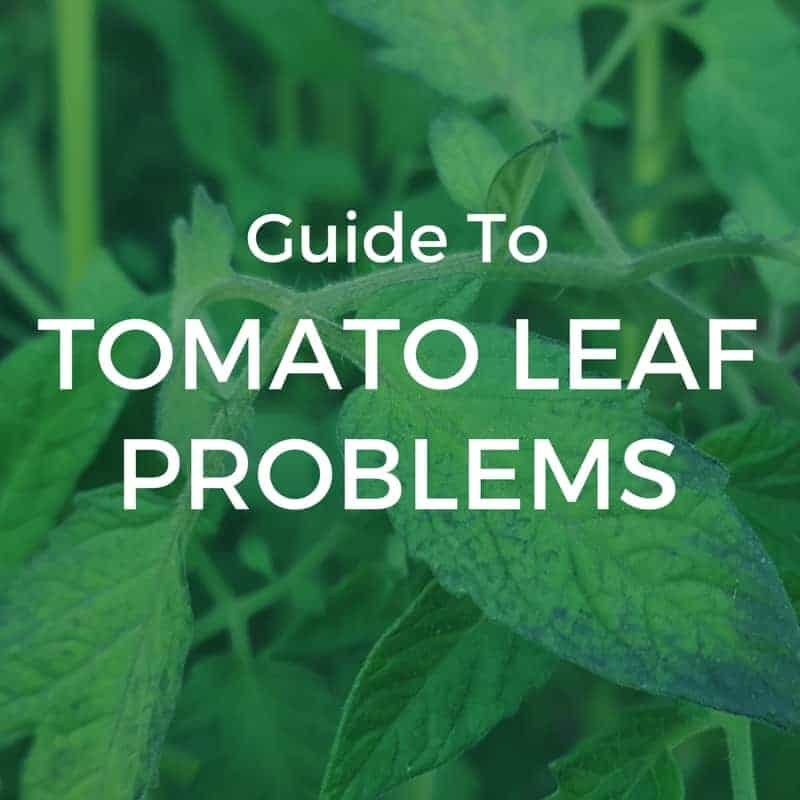


Hi,
This blog is useful for the house gardener. Good blog understandable.
Thank you. 🙂
Hello Laura, do you have much trouble with aphids…here in the uk, i find they can be damaging to our tomatoes and can even wipe them out in a short space of time…
Thanks,
Richard
Hey, Richard. Yes, we do have aphids. Here’s how we deal with them: youshouldgrow.com/get-rid-of-aphids
Hello i have a question i am growing yellow brandywine but not sure about the container size.. is it ok a 10 gallon or should i move to a bigger size like 15gallon first time growing and not sure to what size should i leave them? Cause i don’t have a lot of space! I am watching the smart pots(less weight). Please heeeeeeelp
Hi Adriana, A 10 gallon pot should be fine for growing your tomatoes.
Hello, do you think I could grow Cherokee purple in late containers successfully?
Thank you